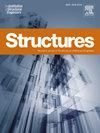Evaluation of flexural cracks in a concrete girder railway bridge using displacement influence lines
IF 4.3
2区 工程技术
Q1 ENGINEERING, CIVIL
引用次数: 0
Abstract
This paper introduces a methodology for detecting flexural cracks in concrete railway bridges based on the displacement influence line (DIL) and a probabilistic damage index formulated using a Bayesian method. Bridge displacement responses were collected under moving train loads and used to derive the most probable DIL, along with associated uncertainties, without requiring prior structural models. A damage indicator was defined based on variations in the DIL coefficients, and damage probability is quantified using Gaussian approximations. The methodology was validated using a finite element model (FE-model) of an existing concrete railway bridge, incorporating rail-structure interactions. To assess the impact of flexural cracks on the overall bridge response, three types of flexural cracks at different locations with varying depths and three measurement locations were considered. The results demonstrated that the DIL-based approach is more sensitive to local flexural cracks than traditional modal parameters. Furthermore, the method allows for potential damage detection using displacement data from a single sensor, unlike modal parameters which necessitate an array of sensors. The proposed framework offers a probabilistic interpretation of damage, enabling infrastructure managers to assess the severity and prioritize inspections. Recommendations for sensor deployment and practical considerations for field applications are discussed to support implementation in real-world bridge monitoring.
用位移影响线评价铁路混凝土梁桥受弯裂缝
本文介绍了一种基于位移影响线(DIL)和贝叶斯概率损伤指标的铁路混凝土桥梁弯曲裂缝检测方法。在移动列车荷载作用下收集桥梁位移响应,并用于推导最可能的DIL,以及相关的不确定性,而不需要事先建立结构模型。基于DIL系数的变化定义了损伤指标,并采用高斯近似对损伤概率进行了量化。采用现有混凝土铁路桥的有限元模型(FE-model)验证了该方法,并考虑了铁路与结构的相互作用。为了评估弯曲裂缝对桥梁整体响应的影响,考虑了三种不同深度位置的弯曲裂缝类型和三个测量位置。结果表明,与传统的模态参数相比,基于模型的方法对局部弯曲裂纹更为敏感。此外,该方法允许使用来自单个传感器的位移数据进行潜在损伤检测,而不像模态参数那样需要一系列传感器。提出的框架提供了损害的概率解释,使基础设施管理人员能够评估严重程度并优先考虑检查。讨论了传感器部署的建议和现场应用的实际考虑,以支持在实际桥梁监测中的实施。
本文章由计算机程序翻译,如有差异,请以英文原文为准。
求助全文
约1分钟内获得全文
求助全文
来源期刊

Structures
Engineering-Architecture
CiteScore
5.70
自引率
17.10%
发文量
1187
期刊介绍:
Structures aims to publish internationally-leading research across the full breadth of structural engineering. Papers for Structures are particularly welcome in which high-quality research will benefit from wide readership of academics and practitioners such that not only high citation rates but also tangible industrial-related pathways to impact are achieved.
 求助内容:
求助内容: 应助结果提醒方式:
应助结果提醒方式:


